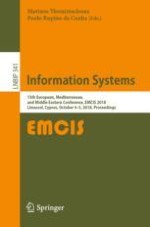This book constitutes selected papers from the 15th European, Mediterranean, and Middle Eastern Conference, EMCIS 2018, held in Limassol, Cyprus, in October 2018. EMCIS is dedicated to the definition and establishment of Information Systems as a discipline of high impact for the methodical community and IS professionals, focusing on approaches that facilitate the identification of innovative research of significant relevance to the IS discipline.
The 34 full and 8 short papers presented in this volume were carefully reviewed and selected from a total of 108 submissions. They were organized in topical sections named: blockchain technology and applications; big data and analytics; cloud computing; digital services and social media; e-government; healthcare information systems; IT governance; and management and organizational issues in information systems.
